Case_7.1-7.4
- 格式:pdf
- 大小:376.82 KB
- 文档页数:6
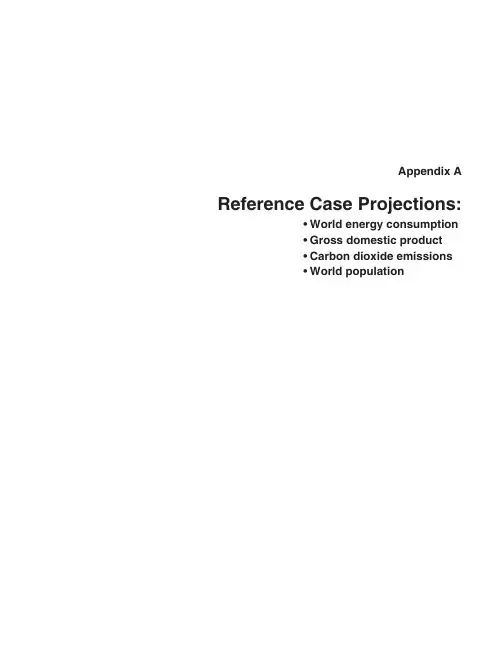
Appendix A Reference Case Projections:•World energy consumption•Gross domestic product•Carbon dioxide emissions•World populationTable A1.World total primary energy consumption by region,Reference case,2005-2035(Quadrillion Btu)Reference case projectionsU.S.Energy Information Administration /International Energy Outlook 2010131Region/CountryHistoryProjections Average annual percent change,2007-203520052006200720152020202520302035OECDOECD North America ...........122.4121.8123.7124.3129.4134.9140.2146.30.6United States a .................100.599.8101.7101.6105.0108.3111.2114.50.4Canada ......................14.814.514.314.615.416.317.218.20.9Mexico.......................7.17.47.78.19.010.411.813.5 2.0OECD Europe .................82.482.982.382.083.085.086.588.20.2OECD Asia....................39.039.539.739.741.843.344.846.30.5Japan .......................23.123.322.821.121.922.122.122.2-0.1South Korea ..................9.39.49.710.611.712.713.814.9 1.5Australia/New Zealand ..........6.6 6.77.28.08.28.58.99.20.9Total OECD .................243.8244.1245.7246.0254.2263.2271.4280.70.5Non-OECDNon-OECD Europe and Eurasia...50.451.051.552.454.256.257.860.20.6Russia.......................29.730.530.530.731.632.833.935.50.5Other........................20.720.621.021.722.523.323.924.70.6Non-OECD Asia................112.6119.6127.1159.3187.8217.0246.9277.3 2.8China........................68.473.078.0101.4121.4142.4162.7181.9 3.1India ........................17.518.820.324.328.231.134.137.6 2.2Other Non-OECD Asia ..........26.727.828.833.738.243.550.257.8 2.5Middle East ...................22.823.925.132.936.539.141.845.7 2.2Africa ........................17.217.317.820.822.524.626.529.0 1.8Central and South America ......26.027.128.032.135.538.742.245.7 1.8Brazil........................11.211.712.314.916.919.321.924.3 2.4Other Central and South America..14.815.415.717.218.619.320.321.4 1.1Total Non-OECD .............229.0239.0249.5297.5336.3375.5415.2458.0 2.2Total World ....................472.7483.1495.2543.5590.5638.7686.5738.7 1.4a Includes the 50States and the District of Columbia.Notes:Energy totals include net imports of coal coke and electricity generated from biomass in the United States.Totals may not equal sum of components due to independent rounding.The electricity portion of the national fuel consumption values consists of generation for domestic use plus an adjustment for electricity trade based on a fuel’s share of total generation in the exporting coun-try.Sources:History:U.S.Energy Information Administration (EIA),International Energy Statistics database (as of November 2009),web site /emeu/international;and International Energy Agency,“Balances of OECD and Non-OECD Statistics”(2009),web site (subscription site).Projections:EIA,Annual Energy Outlook 2010,DOE/EIA-0383(2010)(Washing-ton,DC,April 2010),AEO2010National Energy Modeling System,run AEO2010R.D111809A,web site /oiaf/aeo;and World Energy Projection System Plus (2010).Table A2.World total energy consumption by region and fuel,Reference case,2005-2035(Quadrillion Btu)Appendix A132U.S.Energy Information Administration /International Energy Outlook 2010Region/CountryHistoryProjections Average annual percent change,2007-203520052006200720152020202520302035OECDOECD North AmericaLiquids .....................49.549.049.447.548.149.450.952.50.2Natural gas..................28.128.129.228.330.132.234.035.80.7Coal .......................24.724.324.623.824.425.025.826.90.3Nuclear.....................9.29.49.610.110.810.911.011.30.6Other ......................10.911.111.014.616.017.418.419.8 2.1Total......................122.4121.8123.7124.3129.4134.9140.2146.30.6OECD EuropeLiquids .....................32.332.431.629.027.727.728.028.3-0.4Natural gas..................19.719.719.820.821.722.122.222.60.5Coal .......................12.713.113.211.511.210.910.811.0-0.6Nuclear.....................9.79.69.19.710.010.510.911.20.8Other ......................7.98.18.711.012.413.814.515.1 2.0Total......................82.482.982.382.083.085.086.588.20.2OECD AsiaLiquids .....................17.517.216.915.616.116.516.717.00.0Natural gas..................5.96.3 6.77.47.78.28.38.50.8Coal .......................9.29.310.19.29.29.59.810.40.1Nuclear.....................4.3 4.3 3.9 4.95.76.0 6.57.0 2.1Other ......................2.1 2.2 2.1 2.63.0 3.2 3.3 3.5 1.7Total......................39.039.539.739.741.843.344.846.30.5Total OECDLiquids .....................99.398.697.992.192.093.595.697.70.0Natural gas..................53.754.155.656.559.562.664.666.80.7Coal .......................46.746.747.944.544.845.446.448.30.0Nuclear.....................23.223.322.624.726.527.428.529.5 1.0Other ......................20.921.421.728.231.434.336.338.3 2.0Total......................243.8244.1245.7246.0254.2263.2271.4280.70.5Non-OECDNon-OECD Europe and EurasiaLiquids .....................10.110.310.410.110.010.210.511.00.2Natural gas..................25.825.826.327.328.028.628.729.00.3Coal .......................8.48.88.78.07.98.08.59.40.3Nuclear.....................2.9 2.93.0 3.74.65.5 5.86.3 2.7Other ......................3.2 3.2 3.1 3.3 3.6 3.84.1 4.5 1.4Total......................50.451.051.552.454.256.257.860.20.6Non-OECD AsiaLiquids .....................31.733.434.641.546.953.460.066.5 2.4Natural gas..................8.69.810.817.220.924.026.228.2 3.5Coal .......................61.965.470.381.293.9108.2123.7140.3 2.5Nuclear.....................1.1 1.1 1.2 3.2 5.67.28.59.87.7Other ......................9.39.910.216.220.424.228.532.5 4.2Total......................112.6119.6127.1159.3187.8217.0246.9277.3 2.8See notes at end of table.Table A2.World total energy consumption by region and fuel,Reference case,2005-2035(continued)(Quadrillion Btu)Reference case projectionsU.S.Energy Information Administration /International Energy Outlook 2010133Region/CountryHistoryProjections Average annual percent change,2007-203520052006200720152020202520302035Non-OECD (continued)Middle EastLiquids .....................12.012.513.315.016.117.719.722.7 1.9Natural gas..................10.210.811.217.019.320.220.721.5 2.4Coal .......................0.40.40.40.40.30.30.30.4-0.2Nuclear.....................0.00.00.00.10.20.30.40.5—Other ......................0.30.30.30.40.50.50.60.6 3.1Total......................22.823.925.132.936.539.141.845.7 2.2AfricaLiquids .....................6.1 6.2 6.47.27.48.08.79.4 1.4Natural gas..................3.2 3.1 3.3 5.1 6.1 6.97.17.4 2.9Coal .......................4.2 4.2 4.2 4.2 4.3 4.75.36.2 1.4Nuclear.....................0.10.10.10.20.20.20.20.3 3.6Other ......................3.6 3.6 3.74.2 4.5 4.95.3 5.8 1.6Total......................17.217.317.820.822.524.626.529.0 1.8Central and South AmericaLiquids .....................11.311.812.213.413.614.415.416.3 1.0Natural gas..................4.7 4.8 4.9 6.07.48.08.49.1 2.3Coal .......................0.80.90.90.9 1.0 1.2 1.4 1.7 2.1Nuclear.....................0.20.20.20.30.40.50.50.7 4.2Other ......................9.09.49.811.413.014.616.517.9 2.2Total......................26.027.128.032.135.538.742.245.7 1.8Total Non-OECDLiquids .....................71.174.276.887.394.1103.7114.4125.9 1.8Natural gas..................52.554.256.572.681.787.791.295.2 1.9Coal .......................75.779.784.694.6107.6122.4139.2157.9 2.3Nuclear.....................4.3 4.4 4.57.510.913.715.417.5 4.9Other ......................25.326.527.135.642.048.155.061.4 3.0Total......................229.0239.0249.5297.5336.3375.5415.2458.0 2.2Total WorldLiquids .....................170.4172.8174.7179.3186.0197.2210.0223.60.9Natural gas..................106.3108.3112.1129.1141.2150.2155.8162.0 1.3Coal .......................122.3126.4132.4139.1152.4167.8185.6206.3 1.6Nuclear.....................27.527.827.132.237.441.143.947.1 2.0Other ......................46.247.948.863.873.482.491.299.8 2.6Total......................472.7483.1495.2543.5590.5638.7686.5738.7 1.4Notes:Energy totals include net imports of coal coke and electricity generated from biomass in the United States.Totals may not equal sum of components due to independent rounding.The electricity portion of the national fuel consumption values consists of generation for domestic use plus an adjustment for electricity trade based on a fuel’s share of total generation in the exporting coun-try.Sources:History:U.S.Energy Information Administration (EIA),International Energy Statistics database (as of November 2009),web site /emeu/international;and International Energy Agency,“Balances of OECD and Non-OECD Statistics”(2009),web site (subscription site).Projections:EIA,Annual Energy Outlook 2010,DOE/EIA-0383(2010)(Washing-ton,DC,April 2010),AEO2010National Energy Modeling System,run AEO2010R.D111809A,web site /oiaf/aeo;and World Energy Projection System Plus (2010).Table A3.World gross domestic product (GDP)by region expressed in purchasing power parity,Reference case,2005-2035(Billion 2005dollars)Appendix A134U.S.Energy Information Administration /International Energy Outlook 2010Region/CountryHistoryProjections Average annual percent change,2007-203520052006200720152020202520302035OECDOECD North America ...........14,88315,32715,66218,08121,02324,07227,44531,142 2.5United States a .................12,42212,76813,02715,02217,42719,85122,47525,278 2.4Canada ......................1,1671,2001,2311,4361,6061,7791,9752,192 2.1Mexico.......................1,2931,3591,4051,6241,9902,4422,9943,672 3.5OECD Europe .................13,92814,41214,84916,20818,03519,86421,77123,807 1.7OECD Asia....................5,5355,6815,8506,5307,0897,5578,0448,531 1.4Japan .......................3,8723,9514,0414,2584,4374,5204,6014,6650.5South Korea ..................8929389861,2631,4941,7251,9582,189 2.9Australia/New Zealand ..........7717928231,0091,1571,3111,4851,677 2.6Total OECD .................34,34535,42036,36140,81946,14651,49257,26063,480 2.0Non-OECDNon-OECD Europe and Eurasia...2,9773,2183,4814,1934,9405,7316,5577,440 2.7Russia.......................1,7031,8341,9822,3492,7513,2023,6854,222 2.7Other........................1,2751,3841,4991,8442,1892,5292,8723,218 2.8Non-OECD Asia................11,89713,01314,32324,05531,83240,30749,36659,023 5.2China........................5,4086,0356,82012,73217,35322,44627,59632,755 5.8India ........................2,4402,6762,9184,8476,3427,8339,52911,454 5.0Other Non-OECD Asia ..........4,0494,3024,5856,4768,13710,02812,24114,814 4.3Middle East ...................1,9852,1452,2613,0713,7424,4735,3366,328 3.7Africa ........................2,3602,4942,6383,6394,4065,2216,1027,094 3.6Central and South America ......3,6123,8224,0665,3436,3667,5168,81810,294 3.4Brazil........................1,5341,5951,6852,3502,8773,5054,2505,126 4.1Other Central and South America..2,0792,2272,3812,9933,4894,0114,5685,168 2.8Total Non-OECD .............22,83224,69226,76940,30151,28663,24776,17990,179 4.4Total World ....................57,17760,11263,13081,12097,433114,740133,439153,658 3.2a Includes the 50States and the District of Columbia.Notes:Totals may not equal sum of components due to independent rounding.GDP growth rates for non-OECD Europe and Eur-asia (excluding Russia),China,India,Africa,and Central and South America (excluding Brazil)were adjusted,based on the ana-lyst’s judgment.Sources:History:IHS Global Insight,World Overview (Lexington,MA,various issues).Projections:IHS Global Insight,World Overview ,Third Quarter 2009(Lexington,MA,November 2009);and U.S.Energy Information Administration (EIA),Annual Energy Outlook 2010,DOE/EIA-0383(2010)(Washington,DC,April 2010),AEO2010National Energy Modeling System,run AEO2010R.D111809A,web site /oiaf/aeo.Table A4.World gross domestic product (GDP)by region expressed in market exchange rates,Reference case,2005-2035(Billion 2005dollars)Reference case projectionsU.S.Energy Information Administration /International Energy Outlook 2010143Region/CountryHistoryProjections Average annual percent change,2007-203520052006200720152020202520302035OECDOECD North America ...........14,40614,82715,14517,48320,29423,18326,36129,819 2.4United States a .................12,42212,76813,02715,02217,42719,85122,47525,278 2.4Canada ......................1,1341,1661,1961,3951,5611,7291,9202,130 2.1Mexico.......................8498939221,0661,3071,6031,9662,411 3.5OECD Europe .................14,67215,15715,59416,88918,66520,45322,31924,306 1.6OECD Asia....................6,2226,3826,5677,2827,8708,3518,8529,350 1.3Japan .......................4,5574,6494,7555,0115,2225,3205,4155,4900.5South Korea ..................8458889341,1971,4151,6341,8542,073 2.9Australia/New Zealand ..........8218448771,0751,2331,3971,5821,787 2.6Total OECD .................35,30136,36637,30641,65544,01949,09857,53263,475 1.9Non-OECDNon-OECD Europe and Eurasia...1,3481,4561,5731,8902,2252,5782,9463,340 2.7Russia.......................7648238891,0531,2341,4361,6531,894 2.7Other........................5846336848379911,1421,2931,447 2.7Non-OECD Asia................4,7515,1905,7109,52612,57315,88619,40223,123 5.1China........................2,2442,5042,8305,2837,2009,31311,45013,591 5.8India ........................8138929731,6162,1142,6113,1763,818 5.0Other Non-OECD Asia ..........1,6931,7941,9082,6283,2593,9624,7765,714 4.0Middle East ...................1,0791,1621,2241,6852,0542,4542,9243,463 3.8Africa ........................9831,0391,1001,4931,8132,1602,5412,978 3.6Central and South America ......1,9562,0672,1942,8873,4574,1014,8365,678 3.5Brazil........................8829179691,3511,6542,0152,4432,947 4.1Other Central and South America..1,0751,1501,2261,5371,8032,0852,3932,731 2.9Total Non-OECD .............10,11710,91411,80117,48222,12127,17932,65038,582 4.3Total World ....................45,41747,28049,10659,13666,14076,27790,181102,057 2.6a Includes the 50States and the District of Columbia.Notes:Totals may not equal sum of components due to independent rounding.GDP growth rates for non-OECD Europe and Eur-asia (excluding Russia),China,India,Africa,and Central and South America (excluding Brazil)were adjusted,based on the ana-lyst’s judgment.Sources:History:IHS Global Insight,World Overview (Lexington,MA,various issues).Projections:IHS Global Insight,World Overview ,Third Quarter 2009(Lexington,MA,November 2009);and U.S.Energy Information Administration (EIA),Annual Energy Outlook 2010,DOE/EIA-0383(2010)(Washington,DC,April 2010),Table A19.Table A5.World liquids consumption by region,Reference case,2005-2035(Million barrels per day)Appendix A136U.S.Energy Information Administration /International Energy Outlook 2010Region/CountryHistoryProjections Average annual percent change,2007-203520052006200720152020202520302035OECDOECD North America ...........25.225.025.124.625.025.726.427.40.3United States a .................20.820.720.620.220.621.021.522.10.2Canada ......................2.3 2.3 2.3 2.2 2.2 2.2 2.3 2.40.1Mexico.......................2.1 2.1 2.1 2.2 2.3 2.4 2.7 2.9 1.1OECD Europe .................15.715.715.314.013.413.413.613.7-0.4OECD Asia....................8.68.58.47.78.08.18.38.40.0Japan .......................5.3 5.2 5.0 4.2 4.3 4.3 4.2 4.1-0.7South Korea ..................2.2 2.2 2.2 2.4 2.5 2.7 2.93.1 1.1Australia/New Zealand ..........1.1 1.1 1.1 1.1 1.1 1.1 1.2 1.20.4Total OECD .................49.549.148.846.346.447.248.349.50.0Non-OECDNon-OECD Europe and Eurasia...4.95.0 5.1 4.9 4.9 5.0 5.1 5.40.2Russia.......................2.8 2.9 2.9 2.8 2.7 2.7 2.7 2.80.0Other........................2.1 2.2 2.2 2.1 2.2 2.3 2.4 2.50.5Non-OECD Asia................15.416.216.820.122.725.929.132.3 2.4China........................6.77.37.610.011.613.515.316.9 2.9India ........................2.5 2.7 2.83.2 3.6 3.94.3 4.7 1.8Other Non-OECD Asia ..........6.2 6.2 6.3 6.97.68.59.510.7 1.9Middle East ...................5.86.0 6.47.27.88.59.511.0 1.9Africa ........................3.0 3.0 3.1 3.5 3.6 3.94.2 4.6 1.4Central and South America ......5.5 5.86.0 6.6 6.77.07.58.0 1.0Brazil........................2.2 2.3 2.4 2.83.0 3.3 3.64.0 1.9Other Central and South America..3.3 3.5 3.6 3.7 3.7 3.8 3.94.00.4Total Non-OECD .............34.636.137.342.445.750.455.661.1 1.8Total World ....................84.085.286.188.792.197.6103.9110.60.9a Includes the 50States and the District of Columbia.Note:Totals may not equal sum of components due to independent rounding.Sources:History:U.S.Energy Information Administration (EIA),International Energy Statistics database (as of November 2009),web site /emeu/international.Projections:EIA,Annual Energy Outlook 2010,DOE/EIA-0383(2010)(Washington,DC,April 2010),AEO2010National Energy Modeling System,run AEO2010R.D111809A,web site /oiaf/aeo;and World Energy Projection System Plus (2010).Table A6.World natural gas consumption by region,Reference case,2005-2035(Trillion cubic feet)Reference case projectionsU.S.Energy Information Administration /International Energy Outlook 2010137Region/CountryHistoryProjections Average annual percent change,2007-203520052006200720152020202520302035OECDOECD North America ...........27.327.228.327.429.231.232.934.60.7United States a .................22.021.723.021.722.623.624.324.90.3Canada ......................3.4 3.3 2.9 3.2 3.4 3.74.0 4.3 1.4Mexico.......................1.92.2 2.4 2.53.1 3.94.65.5 3.0OECD Europe .................19.219.119.220.221.021.521.521.90.5OECD Asia....................5.3 5.86.3 6.97.37.77.88.00.8Japan .......................3.1 3.4 3.7 3.8 3.94.0 4.0 4.00.2South Korea ..................1.1 1.1 1.2 1.5 1.6 1.8 1.8 1.8 1.4Australia/New Zealand ..........1.1 1.2 1.3 1.7 1.8 1.92.0 2.1 1.7Total OECD .................51.852.153.754.557.460.362.364.40.6Non-OECDNon-OECD Europe and Eurasia...25.325.325.926.827.528.128.228.50.3Russia.......................16.216.616.716.716.917.217.317.60.2Other........................9.18.79.110.110.610.910.910.90.6Non-OECD Asia................8.59.610.516.720.423.325.527.5 3.5China........................1.72.0 2.5 4.9 6.37.68.79.7 5.0India ........................1.3 1.4 1.5 3.1 3.9 4.3 4.4 4.5 4.1Other Non-OECD Asia ..........5.66.2 6.68.710.211.412.313.3 2.6Middle East ...................9.810.310.716.218.419.319.820.5 2.4Africa ........................3.0 2.9 3.14.85.76.4 6.6 6.8 2.9Central and South America ......4.4 4.5 4.65.67.07.57.98.6 2.3Brazil........................0.70.70.7 1.1 1.5 1.7 2.0 2.3 4.3Other Central and South America..3.7 3.8 3.94.65.5 5.7 5.96.3 1.7Total Non-OECD .............50.952.654.770.178.984.688.091.9 1.9Total World ....................102.7104.6108.5124.7136.3144.9150.3156.3 1.3a Includes the 50States and the District of Columbia.Note:Totals may not equal sum of components due to independent rounding.Sources:History:U.S.Energy Information Administration (EIA),International Energy Statistics database (as of November 2009),web site /emeu/international.Projections:EIA,Annual Energy Outlook 2010,DOE/EIA-0383(2010)(Washington,DC,April 2010),AEO2010National Energy Modeling System,run AEO2010R.D111809A,web site /oiaf/aeo;and World Energy Projection System Plus (2010).Table A7.World coal consumption by region,Reference case,2005-2035(Quadrillion Btu)Appendix A138U.S.Energy Information Administration /International Energy Outlook 2010Region/CountryHistoryProjections Average annual percent change,2007-203520052006200720152020202520302035OECDOECD North America ...........24.724.324.623.824.425.025.826.90.3United States a .................22.822.522.722.323.023.624.325.10.4Canada ......................1.5 1.4 1.5 1.1 1.0 1.1 1.1 1.2-0.8Mexico.......................0.40.40.40.40.40.40.40.6 1.7OECD Europe .................12.713.113.211.511.210.910.811.0-0.6OECD Asia....................9.29.310.19.29.29.59.810.40.1Japan .......................4.6 4.6 4.9 4.2 4.1 3.9 3.8 3.8-0.9South Korea ..................2.1 2.1 2.3 2.2 2.3 2.73.1 3.6 1.6Australia/New Zealand ..........2.6 2.6 2.9 2.8 2.8 2.9 2.93.00.2Total OECD .................46.746.747.944.544.845.446.448.30.0Non-OECDNon-OECD Europe and Eurasia...8.48.88.78.07.98.08.59.40.3Russia.......................4.3 4.4 4.3 4.1 4.1 4.2 4.65.30.8Other........................4.1 4.4 4.4 3.9 3.8 3.8 3.9 4.1-0.2Non-OECD Asia................61.965.470.381.293.9108.2123.7140.3 2.5China........................48.351.054.865.276.488.5100.5112.4 2.6India ........................8.69.210.210.511.512.413.715.5 1.5Other Non-OECD Asia ..........4.95.1 5.4 5.56.07.39.612.4 3.0Middle East ...................0.40.40.40.40.30.30.30.4-0.2Africa ........................4.2 4.2 4.2 4.2 4.3 4.75.36.2 1.4Central and South America ......0.80.90.90.9 1.0 1.2 1.4 1.7 2.1Brazil........................0.40.40.50.50.60.8 1.0 1.2 3.4Other Central and South America..0.40.40.50.40.40.40.40.50.1Total Non-OECD .............75.779.784.694.6107.6122.4139.2157.9 2.3Total World ....................122.3126.4132.4139.1152.4167.8185.6206.3 1.6a Includes the 50States and the District of Columbia.Note:Totals may not equal sum of components due to independent rounding.Sources:History:U.S.Energy Information Administration (EIA),International Energy Statistics database (as of November 2009),web site /emeu/international.Projections:EIA,Annual Energy Outlook 2010,DOE/EIA-0383(2010)(Washington,DC,April 2010),AEO2010National Energy Modeling System,run AEO2010R.D111809A,web site /oiaf/aeo;and World Energy Projection System Plus (2010).Table A8.World nuclear energy consumption by region,Reference case,2005-2035 (Billion kilowatthours)Region/CountryHistory Projections Average annualpercent change,2007-2035 20052006200720152020202520302035OECDOECD North America...........8808919059581,0201,0311,0461,0740.6 United States a.................7827878068348838868868980.4 Canada......................879389113127134142158 2.1 Mexico.......................1010101111111818 2.2 OECD Europe.................9329298799359671,0111,0551,0840.8 OECD Asia....................429430386486560591641683 2.1 Japan.......................290288251311342358388417 1.8 South Korea..................139141136175218233254266 2.4 Australia/New Zealand..........00000000—Total OECD.................2,2402,2502,1712,3792,5482,6342,7422,841 1.0Non-OECDNon-OECD Europe and Eurasia...264269273342425512545588 2.8 Russia.......................140144148197258324345364 3.3 Other........................124124125145167188200224 2.1Non-OECD Asia................1061111193125436988149427.7 China........................5055631863354375125988.4 India........................161616661191561792039.5 Other Non-OECD Asia..........4040416189105123141 4.5 Middle East...................000620293949—Africa........................1210121515212131 3.5 Central and South America......1621192834434362 4.3 Brazil........................1014121822313141 4.4 Other Central and South America..6771012121221 4.2 Total Non-OECD.............3994114237041,0381,3031,4621,672 5.0Total World....................2,6392,6602,5933,0833,5863,9374,2044,514 2.0a Includes the50States and the District of Columbia.Note:Totals may not equal sum of components due to independent rounding.Sources:History:U.S.Energy Information Administration(EIA),International Energy Statistics database(as of November2009), web site /emeu/international.Projections:EIA,Annual Energy Outlook2010,DOE/EIA-0383(2010)(Washington, DC,April2010),AEO2010National Energy Modeling System,run AEO2010R.D111809A,web site /oiaf/aeo;and World Energy Projection System Plus(2010).Table A9.World consumption of hydroelectricity and other renewable energy by region,Reference case, 2005-2035(Quadrillion Btu)Region/CountryHistory Projections Average annualpercent change,2007-2035 20052006200720152020202520302035OECDOECD North America...........10.911.111.014.616.017.418.419.8 2.1 United States a................. 6.1 6.4 6.29.310.111.011.512.4 2.5 Canada...................... 4.2 4.1 4.2 4.5 5.0 5.4 5.8 6.1 1.4 Mexico.......................0.60.60.50.80.8 1.0 1.1 1.3 3.1 OECD Europe.................7.98.18.711.012.413.814.515.1 2.0 OECD Asia.................... 2.1 2.2 2.1 2.6 3.0 3.2 3.3 3.5 1.7 Japan....................... 1.3 1.4 1.3 1.3 1.5 1.6 1.6 1.70.8 South Korea..................0.10.10.10.20.20.20.30.3 3.0 Australia/New Zealand..........0.70.70.7 1.2 1.3 1.4 1.5 1.5 2.8 Total OECD.................20.921.421.728.231.434.336.338.3 2.0Non-OECDNon-OECD Europe and Eurasia... 3.2 3.2 3.1 3.3 3.6 3.8 4.1 4.5 1.4 Russia....................... 1.9 1.9 1.9 2.0 2.2 2.4 2.6 2.8 1.5 Other........................ 1.4 1.3 1.2 1.4 1.4 1.5 1.6 1.7 1.3Non-OECD Asia................9.39.910.216.220.424.228.532.5 4.2 China........................ 4.1 4.5 4.58.711.213.816.418.5 5.2 India........................ 2.3 2.4 2.5 3.2 4.0 4.5 5.1 5.8 3.0 Other Non-OECD Asia.......... 2.9 3.0 3.1 4.3 5.2 5.97.08.2 3.5 Middle East...................0.30.30.30.40.50.50.60.6 3.1 Africa........................ 3.6 3.6 3.7 4.2 4.5 4.9 5.3 5.8 1.6 Central and South America......9.09.49.811.413.014.616.517.9 2.2 Brazil........................ 5.5 5.7 6.27.38.49.711.012.2 2.4 Other Central and South America.. 3.5 3.7 3.6 4.2 4.6 5.0 5.4 5.8 1.7 Total Non-OECD.............25.326.527.135.642.048.155.061.4 3.0Total World....................46.247.948.863.873.482.491.299.8 2.6a Includes the50States and the District of Columbia.Notes:Totals may not equal sum of components due to independent rounding.U.S.totals include net electricity imports,methanol, and liquid hydrogen.Sources:History:U.S.Energy Information Administration(EIA),International Energy Statistics database(as of November2009), web site /emeu/international;and International Energy Agency,“Balances of OECD and Non-OECD Statistics”(2009),web site (subscription site).Projections:EIA,Annual Energy Outlook2010,DOE/EIA-0383(2010)(Washing-ton,DC,April2010),AEO2010National Energy Modeling System,run AEO2010R.D111809A,web site /oiaf/aeo; and World Energy Projection System Plus(2010).Table A10.World carbon dioxide emissions by region,Reference case,2005-2035 (Million metric tons carbon dioxide)Region/CountryHistory Projections Average annualpercent change,2007-2035 20052006200720152020202520302035OECDOECD North America...........7,0126,9157,0176,7346,9047,1637,4267,7040.3 United States a.................5,9745,8945,9865,7315,8516,0166,1766,3200.2 Canada......................6285965865535545796096430.3 Mexico.......................410426444451499568641741 1.8 OECD Europe.................4,3984,4264,3864,1104,0424,0374,0524,107-0.2 OECD Asia....................2,2032,1972,2732,1492,2002,2622,3172,3890.2 Japan.......................1,2541,2531,2621,1021,1141,1061,0851,064-0.6 South Korea..................496486516535570627687757 1.4 Australia/New Zealand..........4534574955125175305465670.5 Total OECD.................13,61313,53813,67612,99313,14713,46213,79614,2000.1Non-OECDNon-OECD Europe and Eurasia...2,8422,8762,8972,8822,9152,9663,0423,1720.3 Russia.......................1,6501,6721,6631,6421,6481,6661,7151,8110.3 Other........................1,1931,2041,2331,2401,2661,2991,3271,3610.4Non-OECD Asia................8,3828,8319,42511,22812,97214,89716,90518,984 2.5 China........................5,5585,8626,2847,7169,05710,51411,94513,326 2.7 India........................1,1871,2871,3991,5661,7511,9052,0792,296 1.8 Other Non-OECD Asia..........1,6371,6811,7431,9462,1632,4782,8823,362 2.4 Middle East...................1,3951,4461,5151,9392,1342,2872,4502,692 2.1 Africa........................9829881,0111,1571,2371,3471,4611,610 1.7 Central and South America......1,0921,1331,1691,3111,4081,5011,6131,734 1.4 Brazil........................366380394478534601682761 2.4 Other Central and South America..7267537758338739019319730.8 Total Non-OECD.............14,69315,27416,01718,51620,66522,99825,47228,193 2.0Total World....................28,30628,81229,69431,50933,81236,46039,26842,392 1.3a Includes the50States and the District of Columbia.Note:The U.S.numbers include carbon dioxide emissions attributable to renewable energy sources.Sources:History:U.S.Energy Information Administration(EIA),International Energy Statistics database(as of November2009), web site /emeu/international.Projections:EIA,Annual Energy Outlook2010,DOE/EIA-0383(2010)(Washington, DC,April2010),AEO2010National Energy Modeling System,run AEO2010R.D111809A,web site /oiaf/aeo;and World Energy Projection System Plus(2010).。


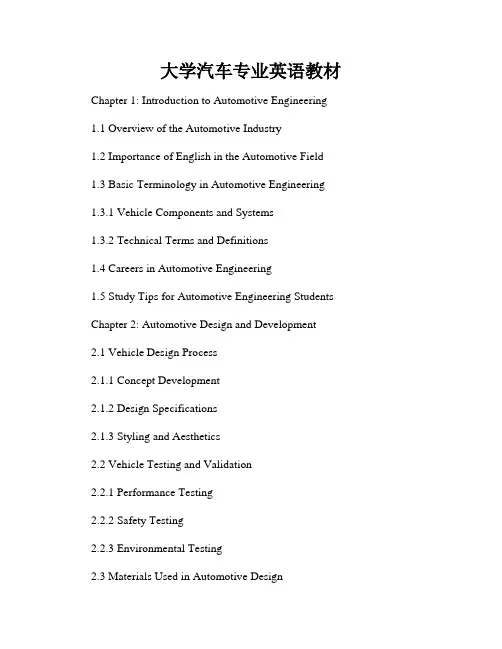
大学汽车专业英语教材Chapter 1: Introduction to Automotive Engineering 1.1 Overview of the Automotive Industry1.2 Importance of English in the Automotive Field 1.3 Basic Terminology in Automotive Engineering 1.3.1 Vehicle Components and Systems1.3.2 Technical Terms and Definitions1.4 Careers in Automotive Engineering1.5 Study Tips for Automotive Engineering Students Chapter 2: Automotive Design and Development2.1 Vehicle Design Process2.1.1 Concept Development2.1.2 Design Specifications2.1.3 Styling and Aesthetics2.2 Vehicle Testing and Validation2.2.1 Performance Testing2.2.2 Safety Testing2.2.3 Environmental Testing2.3 Materials Used in Automotive Design2.3.1 Metals2.3.2 Polymers2.3.3 Composites2.4 Case Studies of Successful Automotive Design Projects Chapter 3: Automotive Powertrain Systems3.1 Internal Combustion Engines3.1.1 Engine Components and Operations3.1.2 Types of Engines3.1.3 Alternative Powertrain Technologies3.2 Transmission Systems3.2.1 Manual Transmissions3.2.2 Automatic Transmissions3.2.3 Continuously Variable Transmissions (CVTs)3.3 Hybrid and Electric Vehicle Technologies3.3.1 Hybrid Electric Vehicles3.3.2 Plug-in Hybrid Electric Vehicles3.3.3 Electric Vehicles3.4 Case Studies on Innovative Powertrain Systems Chapter 4: Automotive Electronics and Control Systems4.1 Introduction to Automotive Electronics4.2 Engine Control Systems4.2.1 Electronic Fuel Injection (EFI)4.2.2 Ignition Systems4.2.3 Engine Management Systems4.3 Vehicle Communication Systems4.3.1 Controller Area Network (CAN)4.3.2 In-Car Entertainment Systems4.3.3 Telematics Systems4.4 Advanced Driver Assistance Systems (ADAS)4.4.1 Adaptive Cruise Control4.4.2 Lane Departure Warning Systems4.4.3 Collision Avoidance Systems4.5 Case Studies on Automotive Electronics and Control Systems Chapter 5: Vehicle Dynamics and Suspension Systems5.1 Basics of Vehicle Dynamics5.1.1 Vehicle Handling and Stability5.1.2 Tire Behavior and Performance5.1.3 Braking Systems5.2 Suspension Systems5.2.1 Types of suspensions5.2.2 Suspension Design and Tuning5.3 Steering Systems5.3.1 Rack and Pinion Steering5.3.2 Power Steering Systems5.3.3 Electronic Steering Systems5.4 Case Studies on Vehicle Dynamics and Suspension Systems Chapter 6: Automotive Safety and Crashworthiness6.1 Importance of Automotive Safety6.2 Passive Safety Systems6.2.1 Seatbelts and Restraint Systems6.2.2 Airbag Systems6.2.3 Safety Cage Design6.3 Active Safety Systems6.3.1 Anti-lock Braking Systems (ABS)6.3.2 Electronic Stability Control (ESC)6.3.3 Adaptive Headlights6.4 Crashworthiness and Impact Analysis6.4.1 Crash Simulation and Testing6.4.2 Energy Absorption Structures6.4.3 Case Studies on Automotive SafetyChapter 7: Automotive Manufacturing and Quality Control7.1 Automotive Manufacturing Processes7.1.1 Stamping7.1.2 Welding7.1.3 Assembly7.2 Lean Manufacturing Principles in the Automotive Industry7.3 Quality Control and Assurance7.3.1 Six Sigma Methodology7.3.2 Statistical Process Control7.3.3 Failure Mode and Effects Analysis (FMEA)7.4 Case Studies on Automotive Manufacturing and Quality ControlConclusionIn conclusion, this English textbook for university-level automotive engineering students provides comprehensive coverage of essential topics in the field. From the fundamentals of automotive design and development to advanced concepts in automotive electronics and control systems, this textbook aims to equip students with the necessary knowledge and skills tosucceed in their future careers. By studying this textbook, students will gain a solid foundation in both technical English vocabulary and automotive engineering principles.。
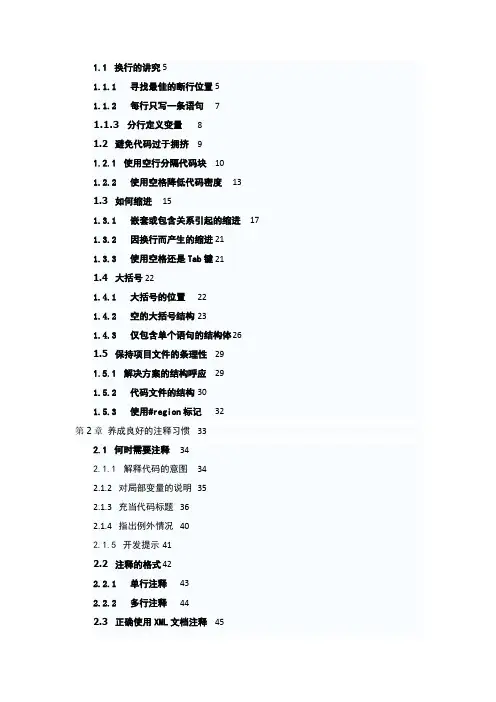
1.1 换行的讲究 51.1.1 寻找最佳的断行位置51.1.2 每行只写一条语句71.1.3 分行定义变量81.2 避免代码过于拥挤91.2.1 使用空行分隔代码块101.2.2 使用空格降低代码密度131.3 如何缩进151.3.1 嵌套或包含关系引起的缩进171.3.2 因换行而产生的缩进201.3.3 使用空格还是Tab键211.4 大括号 221.4.1 大括号的位置221.4.2 空的大括号结构231.4.3 仅包含单个语句的结构体261.5 保持项目文件的条理性291.5.1 解决方案的结构呼应291.5.2 代码文件的结构291.5.3 使用#region标记32第2章养成良好的注释习惯332.1 何时需要注释332.1.1 解释代码的意图342.1.2 对局部变量的说明352.1.3 充当代码标题362.1.4 指出例外情况402.1.5 开发提示 402.2 注释的格式 412.2.1 单行注释422.2.2 多行注释442.3 正确使用XML文档注释452.3.1 结构与类的XML文档注释462.3.2 属性的XML文档注释472.3.3 方法的XML文档注释492.3.4 构造函数的XML文档注释502.3.5 事件的XML文档注释512.3.6 枚举类型的XML文档注释532.3.7 泛型的XML文档注释532.3.8 其他标记54总的来说,如果多看看MSDN自身的类库参考,你会发现其实XML文档注释最终形成的就是这样的结果。
MSDN本身就是一个最好的XML文档注释的范例,我们可以在实践过程中不断地进行模仿和学习。
第7章如何使用函数577.1 为什么要使用函数577.1.1 函数与方法577.1.2 代码复用597.1.3 隐藏细节617.2 函数重载657.2.1 重载的语义657.2.2 保持核心代码唯一707.3 参数的设计747.3.1 参数的命名747.3.2 不要使用保留项747.3.3 变长参数列表757.3.4 何时使用ref参数和out参数777.3.5 参数的顺序787.3.6 重载函数的参数一致797.4 参数检查827.4.1检查零值及空引用837.4.2 检查枚举类型847.4.3 防止数据被篡改857.4.4 在何处检查合法性877.5 函数出口887.5.1 返回值的用法887.5.2 离开函数的时机89假设我们写的是文章而不是程序,那么你一定觉得诸如文章应该分为若干个自然段、每段开头空两格之类的规则是理所当然的。


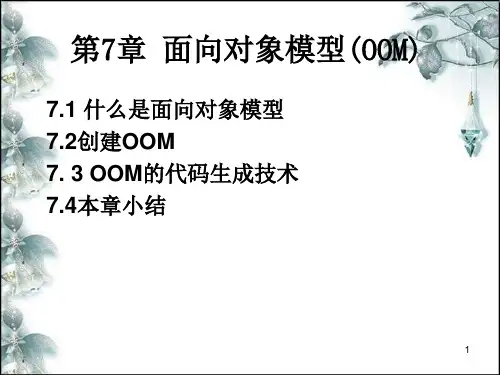
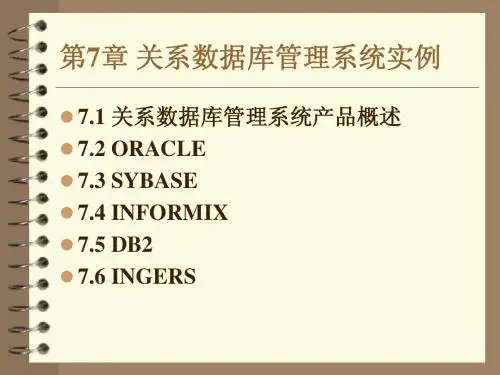

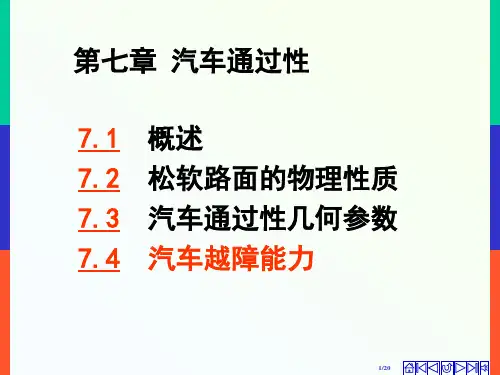
目录 Contents1. 工艺设备Process Equipment 11.1. 塔Column ['kɒləm]1.1.1. 板式塔和填料塔Plate Column and Packed Column 11.1.1.1. 液流型式Liquid –Flow Patterns 21.1.1.2. 泡罩(帽)塔盘Bubble Cap Trays 31.1.1.3. 浮阀塔盘Valve Trays 41.1.1.4. 筛板塔盘Sieve Trays 61.1.1.5. 穿流式塔盘和喷射型塔盘Dual –Flow Trays and Jet Trays 71.1.1.6. 塔盘的支承Supports of Tray 81.1.1.7. 塔底结构及重(再)沸器Bottom Structures and Reboilers 91.1.1.8. 进料和抽出Feed and Draw –Off 101.1.1.9. 填料Packing 121.1.1.10. 液体分配(布)器,再分配(布)器及填料支持版Liquid Distributors, Redistributors and Support Plates 131.1.1.11. 塔附件 Tower Attachments 141.1.1.12. 楼梯(梯子)和平台Stair and Platform 151.1.2. CO2吸收塔CO2 Absorber 161.1.3. 再生塔/CO2汽提塔Regenerator / CO2 Stripper 171.1.4. 造粒塔Prill Tower 181.1.4.1. (造粒塔)总图及造粒喷头组装图General Assembly and Prill-Spray Assembly 181.1.4.2. 造粒塔扒料机Prill tower Reclaimer 201.2. 反应器Reactor1.2.1. 氨合成塔Ammonia Converter 221.2.2. 聚合釜Polymerizer 241.2.3. 电解槽Cell 261.2.3.1. 隔膜电解槽Diaphragm Cells 261.2.3.2. 水银电解槽Mercury Cells 271.3. 贮罐Storage Tanks 281.3.1. 浮顶罐Floating Roof Tanks 301.3.1.1. 浮顶型式 Floating Roof Types 321.3.1.2. 浮顶罐的密封形式 Seal Types of Floating Roof Tank 34 1.3.2. 内浮顶罐 Covered Floating Roof Tanks 351.3.3. 低温贮罐Refrigerated Storage Tanks 361.4. 蒸发器Evaporators 371.5. 换热器Heat Exchangers1.5.1. 换热器的名称Nomenclature of Heat Exchanger 401.5.1.1. 换热器部件Components of Heat Exchanger 401.5.1.2. 固定端头盖(或管箱),壳体及后端头盖型式Types of Stationary Head, Shell and Rear End Head 421.5.1.3. 管板Tube sheets 431.5.1.4. 管子-管板连接,膨胀节及其他零件Tube-Tube Sheet Joints, Expansion Joints and Other Parts 441.5.1.5. 横向折流板和纵向折流板Transverse Baffles and Longitudinal Baffles 461.5.2. 套管式换热器和刮面式换热器Double-Pipe Heat Exchanger and Scraped-Surface Exchanger 471.5.3. 套管式纵向翅片换热器Double Pipe Longitudinal Finned Exchanger 481.5.4. 板式换热器Plate-Type Exchangers 491.5.5. 蒸汽表面冷凝器,凝汽器Steam Surface Condensers 50 1.5.6. 空冷器,空气冷却器Air-Cooled Heat Exchangers1.5.6.1. 空冷器的组合形式Bay Arrangements of Air-Cooled Heat Exchanger 521.5.6.2. 管束和头盖(管箱)的典型结构Typical Construction of Tube Bundles and Headers 531.5.6.3. 空冷器的驱动装置Drive Arrangements for Air Cooler 541.5.6.4. 翅片Fins 551.5.6.5. 空冷器的温度控制Temperature Control of Air Cooler 561.5.7. 冷却塔,凉水塔(1)Cooling Towers(Ⅰ) 57冷却塔,凉水塔(2)Cooling Towers(Ⅱ) 581.6. 工业炉Furnace1.6.1. 管式加热炉Pipe Heater 601.6.1.1. 管式加热炉型式Types of pipe Heaters (pipe Still Heater) 601.6.1.2. 加热炉Heaters1.1.6.3. 燃烧器,烧嘴Burners 631.1.6.4. 炉管,联管箱和回弯头Tube, Headers and Return Bends 641.1.6.5. 管架Tube Supports 651.6.2. 转化炉Reformers (Reforming Furnaces) 661.6.3. 二段转化炉Secondary Reformer 671.6.4. 变换炉Shift Converter 681.6.5. 热回收和废热锅炉Heat Recovery and Waste Heat Boiler 691.6.5.1. 热回收Heat Recovery 691.6.5.2. CO燃烧废热锅炉CO Firing Waste Heat Boiler 70 1.6.5.3. 第一废热锅炉Primary Waste Heat Boiler 711.6.5.4. 第二废热锅炉Secondary Waste Heat Boiler 72 1.6.6. 火炬Flare Stacks 731.7. 混合设备Mixing Equipment 741.7.1. 搅拌器型式(1)Types of Agitator(Ⅰ) 74搅拌器型式(2)Types of Agitator(Ⅱ) 761.7.2. 混合(搅拌)槽Mixing Tanks 771.7.3. 管道混合器Line Mixers (Flow Mixers) 781.7.4. 静止混合器Static Mixers 791.7.5. 膏状物料及粘性物料混(拌)合设备Paste and Viscous-Material Mixing Equipments 801.7.6. 固体混合机械Solids Mixing Machines 821.7.7. 双螺杆连续混合机Double Screw Continuous Mixer 83 1.8. 萃取器Extractors 841.8.1. 连续萃取设备,连续抽提设备Continuous Contact (Differential Contact) Equipments 841.8.2. 浸提设备Leaching Equipments 861.9. 旋风分离器、沉清器、过滤器和离心机Cyclone, Decanter, Filter and Centrifuge 871.9.1. 旋风分离器(1)Cyclone Separators (Ⅰ) 87旋风分离器(2)Cyclone Separators (Ⅱ) 881.9.2. 气体洗涤器Gas Scrubbers 901.9.3. 沉降罐,澄清器Gravity Settlers (Decanters) 921.9.4. 过滤机Filter 931.9.4.1 压滤机Pressure Filters 931.9.4.2 叶滤机Pressure Leaf Filters 941.9.4.3 袋式过滤器Bag Filters 951.9.4.4 转鼓真空过滤机Rotary-Drum Vacuum Filter 961.9.5. 离心式分离机Centrifugal Separator 971.9.5.1. 双鼓真空离心过滤机Double-Bowl Vacuum Centrifuge 971.9.5.2. 离心机Centrifuges 981.9.5.3. 静止叶片型离心式分离器Stationary Vane Type Centrifugal Separators 1001.10. 干燥器Dryers 1011.10.1. 间接干燥器Indirect Dryers 1011.10.2. 直接干燥器Direct Dryers 1021.10.3. 喷雾干燥器Spray Dryers 1041.10.3.1. 雾化喷头,喷雾嘴,雾化器Spray Nozzles (Atomizers) 1051.10.4. 气流(气动)输送干燥器Pneumatic Conveyor Dryers 106 1.11. 其他Miscellaneous 1071.11.1. 石油炼制中的流化过程Fluidization Processes in Petroleum Refinery 1071.11.1.1. 流态化Fluidization 1081.11.1.2. 流化床分布器Distributors for Fluidized Bed 1091.11.2. 破沫器及其应用Demister and Its Applications 1101.11.2.1. 破沫网的安装和纤维除雾器Installation of Mesh and Fiber Mist Eliminator 1111.11.3. 设备的支座和封头Supports and Heads of Equipments 1121.11.4. 立式容器的外部保温External Thermal Insulation for Vertical Vessel 1132. 泵Pump2.1. 各种型式的泵(1) Various Types of Pump (Ⅰ) 114各种型式的泵(2) Various Types of Pump (Ⅱ) 116各种型式的泵(3) Various Types of Pump (Ⅲ) 117各种型式的泵(4) Various Types of Pump (Ⅳ) 1182.2. 离心泵(1) Centrifugal Pump(Ⅰ) 119离心泵(2) Centrifugal Pump(Ⅱ) 120离心泵(3) Centrifugal Pump(Ⅲ) 1212.3. 管道泵Inline Pump 1222.4. 双作用蒸汽往复泵Duplex Acting Steam-Driven Reciprocating Pump 1232.5. 双作用活塞式往复泵Double Action Reciprocating Pump, Bucket Type 1242.6. 混流泵 Mixed-Flow Pump 1262.7. 计量泵Metering Pumps 1272.8. 喷射泵Jet Pumps 1282.9. 喷射装置Ejector Units 1292.9.1. 喷射器的结构Ejector Structures 1303. 压缩机、鼓风机和风机Compressors Blowers and Fans3.1. 螺杆压缩机Screw Compressors 1313.2. 旋转式螺杆压缩机Rotary Helical Screw Compressors 132 3.3. 活塞式压缩机Piston Compressors 1333.4. 往复式压缩机Reciprocating Compressors 1343.5. 低密度聚乙烯(超)高压压缩机High Pressure Compressor for Low Density Polyethylene Process 1363.5.1. 高压气缸和中心型组合阀High-Pressure Cylinder and Central Valve 1383.5.2. 卸荷阀并及其他阀Unloading Valve and Other Valves 1403.6. 水平剖分式离心压缩机Horizontally Split Centrifugal Compressor 1423.7. 鼓风机,压气机Blowers 1443.8. 风机Fans 1463.9. 典型的空气压缩机装置Typical Compressor Installation 1484. 输送机和提升机 Conveyor and Elevator 1494.1. 垂直提升(输送)机Vertical Elevator (Conveyor) 1494.1.1. 斗式提升机Bucket Elevator 1494.1.2. 垂直提升输送机和箱类提升机Vertical Rising Conveyor and Case Elevator 1504.1.3. 双带提升机Twin Riser 1514.2. 带式输送机Band (Belt) Conveyor 1524.2.1. 带式输送机示意图Band Conveyor Sketch 1524.2.2. 输送机系统Conveyor Systems 1534.2.3. 带式输送机Band Conveyor 1544.2.4. 中心距超过600英尺的单轮传动带式输送机用的张紧装置Take-up Unit for Single Drum Drive Belt Conveyor Exceeding 600 Feet Centers 1554.2.5. 双轮传动带式输送机的张紧装置Take-up Unit for Dual Drum Drive Belt Conveyor 1564.2.6. 拼装式皮带运输机和移动式皮带运输机Pre-built Sectional Belt Conveyor and Mobile Belt Conveyor 1574.3. 螺旋输送机Screw Conveyor 1584.4. 吊挂式链输送机和振动输送机Chain Trolley Conveyor and Vibrating Conveyor 1594.4.1. 吊挂式链输送机部件Units of Chain Trolley Conveyor 160 4.5. 辊子输送机Roller Conveyors 1624.6. 惰轮(托辊)型式Types of Idlers 1634.6.1. 托辊(惰轮)结构Construction of Iders 1645. 破碎和筛分设备Crushing and Screening Equipment 1665.1. 颚式破碎机Jaw crusher 1665.2. 颚式冲击破碎机Impact Jaw Crusher 1685.3. 回转球形破碎机Gyrasphere Crusher 1695.4. 盘式回转破碎机Tray Type Gyratory Crusher 1705.5. 液压锥形破碎机和冲击式破碎机(叶片破碎机) Hydraulic Cone Crusher and Impact Crusher (Impeller Breaker) 1725.6. 辊子粉碎机Roller Mill 1735.7. 双轴锤击破碎机Double Shaft Hammer Mill 1745.8. 球磨机Ball Mill 1765.9. 干燥粉磨机Dryer-Pulveriser 1775.10. 返混设备布置Layout of Back mixing Equipment 1785.11. 振动筛Vibrating Screen 1795.12. 分级机Classifiers 1806. 塑料和橡胶加工成型机械 Forming Machine For Plastics and Rubber 1816.1. 挤压机Extruder 1816.2. 螺杆注塑机Screw Injection Molding Machine 1826.3. 聚氯乙烯辊压机生产线Calender Line for PVC Production 1836.4. 四辊辊压机Four-Roll Calender 1847. 给料机,称量器和包装机Feeder, Weighing and Bagging Machine 1867.1. 振动给料机Vibrating Feeder 1867.2. 电振动给料机Electric Vibrating Feeder 1887.3. 板式给料机Apron Feeder 1897.4. (粉末)均匀自动给料机Smooth Auto-Feeder 1907.5. 带式计量秤Dosing Belt Weigher 1917.6. 定量给料秤Constant Feed Weigher 1927.7. 自动装袋系统 Automatic Bagging System 1938. 汽轮机Steam Turbine 1948.1. 汽轮机的分类(1) Classification of Steam Turbines (Ⅰ) 194 汽轮机的分类(2) Classification of Steam Turbines (Ⅱ) 1968.2. 汽轮机的循环Steam Turbine Cycles 1978.3. 汽轮机供汽方式 Methods of Steam Supply to a Turbine 198 8.4. 单级汽轮机Single Stage Steam Turbine 1998.5. 冲动式汽轮机Impulse Turbines 2008.6. 汽轮机轴封Turbine Glands and Gland Sealings 2028.7. 汽轮机的润滑Lubrication of Steam Turbine 2048.8. 汽轮机调速器及调速Governors and Governing of Steam Turbine 2068.9. 汽轮机调速器 Turbine Governor 2088.10. 超速脱扣装置(保安器) Overspeed Tripping Device 2108.11. 汽轮机的安装 Installation of Steam Turbine 2119. 锅炉 Boiler 2129.1. 火管锅炉及水管锅炉的基本型式 Basic Patterns for Fire and Water Tube Boiler 2129.2. 椭圆管板换热器 Ellipsoidal Shell and Tube Heat Exchanger2139.3. 水冷管夹套换热器 Cooling Tubes and Jacket Heat Exchanger 2149.4. 蒸汽净化及锅筒内件(1) Steam Purification and Drum Internals (Ⅰ) 215蒸汽净化及锅筒内件(2) Steam Purification and Drum Internals (Ⅱ) 216蒸汽净化及锅筒内件(3) Steam Purification and Drum Internals (Ⅲ) 218蒸汽净化及锅筒内件(4) Steam Purification and Drum Internals (Ⅳ) 2199.5. 过热器 Superheater 2209.6. 减温器 Attemperators 2219.7. 空气预热器 Air Preheater 2229.8. 炉排 Grates 2249.9. 下饲炉排 Underfeed Stoker 2259.10. 喷燃器,燃烧器 Burners 2269.11. 省煤器 Economizer 2289.12. 抛煤机 Spreader Feeders 2299.13. 磨煤机 Pulverizers 23010. 机械零件 Machine Element 23110.1. 万向节 FUniversal Joints 23110.2. 联轴器 Couplings 23210.3. 液力联轴器(1) Fluid Couplings (Ⅰ) 234液力联轴器(2) Fluid Couplings (Ⅱ) 23510.4. 轴颈密封,圆周密封 Circumferential Seals 23610.5. 端面密封,轴封,轴端连接件 Face Seals, Shaft Sealings and End Fittings 23710.6. 滚子轴承,滚柱轴承 Roller Bearings 23810.7. 球轴承,滚珠轴承Ball Bearings 23910.8. 加油机构 Oiling Devices 24010.9. 紧固件 Fastener 24110.9.1. 螺栓和双头螺柱 Bolts and Studs (stud bolts) 24110.9.2. 螺钉的头部和端部型式 Heads and Points of Screw 242 10.9.3. 螺母 Nuts 24310.9.4. 非螺纹紧固件 Non-threaded Fasteners 24411. 配管(管路)和管件 Piping and Fitting 24511.1. 阀杆与阀盖结构 Valve Stem and Bonnet Designs 24511.2. 阀门(1) Valves(Ⅰ) 246阀门(2) Valves(Ⅱ) 248阀门(3) Valves(Ⅲ) 249阀门(4) Valves(Ⅳ) 25011.3. 闸阀 Gate Valve 25111.4. 截止阀 Globe Valve 25211.5. 球阀 Ball Valve 25311.6. 止回阀 Check Valve 25411.7. 弹簧安全泄压阀 Spring Safety-Relief Valve 25511.8. 液面控制浮球阀 Pilot Operated Ball Float Valve 25611.9. 波纹管密封闸门阀 Bellows Sealed Gate Valve 25711.10. 热膨胀阀 Thermo Expansion Valve 25811.11. 阀门操纵机构 Valve Operating Mechanisms 25911.12. 蒸汽疏水阀(器)和空气疏水阀(器) Steam Traps and Air Traps 26011.13. 管道附件 Pipe Line Fitments 26211.14. 法兰、法兰密封面及垫片 Flanges, Flange Facings and Gaskets 26411.15. 填料 Packings 26611.16. 管件 Pipe Fitting 26711.16.1. 法兰管件 Flanged Fittings 26711.16.2. 螺纹管件 Threaded Fittings 26811.16.3. 钢焊接管件 Steel-Welding Fittings 26911.17. 塑料压接管接头 Plastics Compression Joints 27011.18. 预制弯管与膨胀节 Fabricated Pipe Bends and Expansion Joints 27111.19. 管子连接 Joints in Tubing and Pipe 27211.20. 管道绝热 Piping Insulation 27311.21. 管吊与管支架 Pipe Hangers and Pipe Supports 274 11.22. 急救冲洗和洗眼站 Safety Shower and EyewashStation Hose Station 软管站27612. 量测仪表 Instrumentation 27712.1. 液位(面)计 Level Gage 27712.1.1. 就地安装直读液面计 Locally Mounted Direct Reading Level Gages 27712.1.2. 浮筒式液面计 Displacement Type Level Gages 278 12.1.3. 液面调节器及液位开关 Level Controllers and Switches 27912.2. 压力测量仪表 Pressure Instruments 28012.2.1. 液体压力计 Manometers 28212.2.2. 压力测量的新成果 New Developments in Pressure Measurements 28312.2.3. 压力表的安装 Installation of Pressure Guage 28412.3. 流量测量元件 Flow Measuring Element 28512.3.1. 速率式流量计 Inferential Meters①(Fluid Velocity Meter) 28512.3.1.1. 涡轮流量计 Turbine Meter 28512.3.1.2. 漩涡流量计 Vortex flow meter 28612.3.1.3. 漩涡流量计测量系统 Vortex Flow meter Measurement System 28712.3.2. 一次流量元件 Primary Flow Elements 28812.3.3. 容积式流量计 Positive Displacement Type Flow Meters 29012.3.4. 可变面积(定压降)式流量计 Variable Area Type Flow Meters 29212.3.5. 差压流量计的安装 Installation of Head Meters 29412.3.6. 面积式流量计及计量泵 Area Meters and metering pumps 29612.3.7. 其他流量计(1) Other Flow Meters(Ⅰ) 297其他流量计(2) Other Flow Meters(Ⅱ) 29812.4. 温度计 Thermometer 29912.4.1. 热电偶 Thermocouple 29912.4.2. 液体膨胀温度计及双金属温度计 Liquid Expansion and Bimetallic Thermometer 30012.4.3. 电阻式温度计及热敏电阻 Resistance Thermometer and Thermistor 30212.4.4. 压力式温度计 Filled System Thermometer 30312.4.5. 辐射高温计 Radiation Pyrometer 30412.4.6. 光学高温计 Optical Pyrometer 30512.4.7. 电动指示调节器 Electritic Indicating Controller 30612.4.8. 气动指示调节器 Pneumatic Indicating Controller 307 12.4.9. 多点长图温度记录仪 Multi-Point Long Chart TemperatureRecorder 30812.4.10. 控制操作箱 Control Station 30912.4.11. 记录纸 Charts 31012.5. 变送器 Transmitter 31112.5.1. 压力变送器 Pressure Transmitter 31112.5.2. 差压变送器 Differential Pressure Transmitters 31212.5.3. 气动温度变送器 Pneumatic Temperature Transmitter 314 12.5.4. 物位变送器 Level Transmitters 31512.6. 调节(控制)器 Controller 31612.6.1. 液位调节器 Liquid Level Controller 31612.6.2. 气动调节器 Pneumatic Controller 31712.6.3. 弹簧管调节器 Bourdon Tube Controller 31812.7. 调节阀 Control Valve 31912.7.1. 薄膜及活塞执行机构 Diaphragm and Piston Actuators 320 12.7.2. 调节阀阀盖 Bonnets of Control Valve 32112.7.3. 调节阀阀体(1) Control Valve Bodies (Ⅰ) 322调节阀阀体(2) Control Valve Bodies (Ⅱ) 32312.7.4. 阀芯及笼式阀芯 Valve plugs and Cages 32412.7.5. 阀内组件(组成)部分 Components Valve Trim①32512.7.6. 调节阀的作用及导向 Acting and Guiding of Control Valve 32612.7.7. 调节阀定位器 Positioner of Control Valve 32712.7.8. 调节阀手动机构 Handjack Assembly of Control Valve 328 12.7.9. 气动活塞定位器 Pneumatic Piston Positioner 32912.8. 氧分析器 Oxygen Analysis Equipment 33012.9. 二氧化碳分析器 Carbon Dioxide Analyzer 33212.10. PH计 pH meters 33312.11. 粘度测量仪表 Viscosity Measuring Instruments 33412.12. 比重仪表 Specific Gravity Instrument 33612.13. 速度测量与控制 Speed Measurement and Control 337 12.14. 仪表盘 Instrument Panels 33812.15. 温度控制 Temperature Control 34012.16. 信号系统Annunciators Systems 34112.16.1. 集中式信号器 Integral Annunciators 34212.16.2. 分离式信号器及半模拟式信号器 Remote Annunciator and Semigraphic Annunciator 34312.17. 继动器 Relays 34412.18. 仪表管件及仪表箱 Instrumentation Tube Fittings and Housings 34612.19. 仪表图例符号及名称 Instrumentation Symbols and Identifications 34812.20. 总体分散控制系统(1) Total Distributed Control System(Ⅰ) 35012.21. 总体分散系统(2) Total Distributed Control System(Ⅱ) 35112.22. 总体分散系统(3) Total Distributed Control System(Ⅲ) 352 12.23. 总体分散系统(4) Total Distributed Control System(Ⅳ) 353 12.24. 总体分散系统(5) Total Distributed Control System(Ⅴ) 35412.25. 总体分散系统(6) Total Distributed Control System(Ⅵ) 35513. 电气工程 Electrical Engineering 35613.1. 旋转电机 Electrical Rotating Machine 35613.1.1. 直流电机 Direct-Current Machine 35613.1.2. 直流发电机 Direct-Current Generator 35713.1.3. AC换向电机 AC Commutator Machine 35813.1.4. 交流电动机 Alternating-Current Motor 35913.1.5. 滑环式感应电动机 Slip-ring Type Induction Motor 360 13.1.6. 无刷同步电动机 Brushless Synchronous Motor 36213.1.7. 同步电动机的无刷励磁 Brushless Excitation of Synchronous Motor 36313.1.8. 线槽和绕组 Slots and Windings 36413.2. 变压器 Transformer 36513.2.1. 油浸式变压器正视图 Oil Immersed Transformer Front View 36513.2.2. 油浸式变压器侧视图 Oil Immersed Transformer Side View 36613.2.3. 油浸式变压器外视图 Oil Immersed Transformer Exterior 36713.3. 整流器和电池 Rectifier and Battery 36813.3.1. 整流器 Rectifier 36813.3.2. 原电池(1) Primary Batteries(Ⅰ) 369原电池(2) Primary Batteries(Ⅱ) 37013.4. 高压开关装置 High Voltage Switchgear 37213.4.1. 金属封闭式开关装置 Metal-Enclosed Switchgear 372 13.4.2. 金属高压开关柜 Metal-Clad High-Voltage Cubicle 373 13.4.3. 六氟化硫断路器 SF6 Circuit-Breaker 37413.4.4. T型断路器 T-Breaker 37613.4.5. 电动机操纵机构 Motor Drive 37713.5. 低压开关 Low-Voltage Switches 37813.5.1. 限流空气断器 Currentt-Limiting Air-Break Circuit-Breaker 37813.5.2. 塑料外壳断路器 Moulded Case Circuit-Breaker 37913.5.3. 控制开关 Control Switches 38013.5.3.1. 按钮开关 Pushbutton Switches 38213.5.3.2. 凸轮旋转开关 Cam Switches 38413.6. 电磁设备 Electromagnetic Apparatus 38613.6.1. 电磁机构和器件 Electromagnetic Mechanism and Devices 38613.6.2. 电磁继电器 Electromagnetic Relays 38813.6.3. 电压调整继电器 Voltage Regulating Relay 39013.7. 电气防爆 Electrical Explosion-proof 39113.7.1. 危险场所内的电力和照明安装 Power and Lighting Installation in Hazardous Location 39113.7.2. 防爆设备 Explosion-proof Apparatus 39213.8. 供电系统 Power Supply System 39413.8.1. 热电厂 Thermal Power Plant 39413.8.1.1. 节能发电厂 Energy Saving Power plant 396 13.8.2. 变电所屋内配电装置 Indoor Installations of Electric Substation 39813.8.3. 铁塔及电杆 Towers and Poles 39913.8.4. 静电除尘器 Electrostatic Precipitator 40013.9. 内线 Interior Wiring 40113.9.1. 电缆 Cables 40113.9.2. 熔断器 Fuses 40413.9.3. 连接器和端子 Connectors and Terminals 406 13.9.4. 灯泡 Lamps 40713.9.5. 电热器件 Electroheating Devices 40814. 施工设备和工具 Construction Equipment and Tool 409 14.1. 起重机械 Hoisting Machinery 40914.1.1. 桅杆起重机,转臂起重机 Derricks 40914.1.2. 安装起重机 Erecting Cranes 41014.1.3. 起重设备 Hoisting Devices 41214.1.4. 起重机(1) Cranes(Ⅰ) 413起重机(2) Cranes(Ⅱ) 414起重机(3) Cranes(Ⅲ) 41514.1.5. 手拉葫芦和千斤顶 Chain Hoists and Jacks 41614.1.6. 麻绳,钢丝绳,绳结和吊索 Hemp Ropes, Cable Wires, Knots and Sling Chains 41814.1.7. 起重机用的起吊附件 Lifting Attachments for Crane Use 42014.1.8. 叉式起重车的附属配件 Fork-Truck Attachments 421 14.2. 工具 Tools 42214.2.1. 扳手 Wrenches 42214.2.2. 活扳手及管钳 Adjustable Wrenches and Pipe Wrenches 42314.2.3. 钳和剪钳 Pliers and Nippers 42414.2.4. 刀具的柄部、套节及套筒 Shanks, Sockets and Sleeves 42514.2.5. 丝锥 Taps 42614.2.6. 绞刀 Reamers 42714.2.7. 麻花钻 Twist Drills 42814.2.8. 木工工具 Wood Working Tools 42914.2.9. 检测规 Inspection Gages 43014.2.10. 量具 Measuring Tools 43115. 焊接 Welding 43215.1. 金属焊接 Welding of Metals 43215.2. 焊接符号 Welding Symbols 43415.3. 保护式电弧焊原理 Principles of Shielded Arc Welding 435 15.4. 焊接位置、接头形式及焊接形式 Welding Positions, Types of Joints and Welding 43615.5. 坡口 Grooves 43715.6. 坡口详图 Detail of Grooves 43815.7. 焊接缺陷 Defects of Welding 43915.8. 填角焊,角焊 Fillet Welding 44015.9. 自动埋弧焊 Automatic Submerged Arc Welding 44115.10. 气体保护电弧焊 Gas-Shielded Arc Welding 44215.11. 金属极楕性气体保护焊 Gas Metal-Arc welding 44415.12. 金属极气体保护焊焊枪 Electrode Guns of Gas Metal-Arc Welding 44515.13. 普通电渣焊 Conventional Electroslag Welding 44615.14. 熔嘴电渣焊 Electroslag Welding by Consumable Guide Tube 44715.15. 电气焊 Electrogas Welding 44815.16. 管状焊丝电弧焊 Flux-Cored Arc Welding 45015.17. 气焊设备 Gas Welding Equipment 45115.18. 移动式乙炔发生器 Portable Acetylene Generators 45215.19. 乙炔发生器的基本型式 Basic Types of Acetylene Generators 45315.20. 塑料焊接(1) Welding of Plastics(Ⅰ) 454塑料焊接(2) Welding of Plastics(Ⅱ) 45516. 无损检验 No-Destructive Testing 45616.1. 无损检验方法 Non-Destructive Testing Method 45616.2. 探孔镜及显微镜 Borescope and Microscope 45816.3. X射线发生管及其线路 X-ray Tube and Its Circuit 45916.4. 射线照相及电子照相 Photoradiography and Electroradiography 46016.5. 轻便X射线机及透度计 Mobile X-ray Unit and Penetrometer 46116.6. 超声波探伤方法及探头 Ultrasonic Test Methods and Search Units 46216.7. 超声波发射探头及接受探头 Ultrasonic Transducer and Refraction 46316.8. 配管焊缝的超声波探伤 Ultrasonic Testing of Weld in Tubing 46416.9. 液体渗透试验 Liquid Penetrant Test 46516.10. 磁化法 Methods of Magnetization 46617. 土建工程 Civil Engineering and Building 46717.1. 地形图和土层剖面图 Topographical Map and Subsoil Profile46717.2. 土壤与基础 Soils and Foundations 46817.3. 桩的形式 Types of Pile 46917.4. 设备基础 Foundations for Equipment 47017.5. 大型设备的锚固(1) Anchorage of Heavy Machine(Ⅰ) 471大型设备的锚固(2) Anchorage of Heavy Machine(Ⅱ) 47217.6. 道路和路面 Road and Paving 47317.7. 屋顶的形式 Types of Roof 47417.8. 薄壳屋顶 Shell Roofs 47517.9. 钢筋混凝土结构 Reinforced Concrete Construction 476 17.10. 钢结构 Steel Construction 47817.10.1. 钢结构连接详图 Structural Steel Connection Details 480 17.10.2. 钢构件的连接 Connection of Steel Members 48117.10.3. 钢栏杆 Steel Balustrade 48217.10.4. 钢扶梯和梯子 Steel Stairs and Ladders 48317.11. 多层工业厂房 Multistory Industrial Buildings 48417.12. 门的形式 Types of Doors 48517.13. 窗的形式 Types of Windows 48617.13.1. 窗的组成 Components of a Window 48717.14. 工业构筑物 Industrial Structures 48817.14.1. 管支架 Pipe Supports 48817.14.2. 烟囱的形式 Types of Chimneys 49017.14.3. 排气筒 Vent Stacks 49117.14.4. 水塔的形式 Types of Water Towers 49217.14.5. 冷却塔 Cooling Towers 49317.14.6. 通廊和栈桥 Galleries and Trestles 49417.14.7. 筒仓和贮斗 Silos and Bunkers 49518. 实验室仪器 Laboratory Apparatus and Instruments 49618.1. 实验室常用仪器(1) General Apparatus and Instruments(Ⅰ) 496实验室常用仪器(2) General Apparatus and Instruments(Ⅱ) 498 18.2. 石油产品的蒸馏 Distillation of Petroleum Products 499 18.3. 粘度计 Viscometer 50018.4. 比重天平,韦氏天平 Specific Gravity Balance (Westphal Balance) 50118.5. 闪点和燃点测定器 Flash and Fire Points Apparatus 502 18.6. 残碳及含水量 Carbon Residue and Water Content 503 18.7. 冰点,凝点和融点 Freezing Point, Pour Point and Melting Point 50418.8. 脆裂点,针入度及软化点 Breaking Point, Cone penetration and Softening Point 50518.9. 吸附柱 Absorption Column 50619. 流程图和管道布置图 Flow Diagram and piping Layout 507 19.1. 工厂平面布置总图 Master Plot Plan 50719.2. 炼厂加工流程图(1) Diagrammatic Flow Sheet of Petroleum Refinery(Ⅰ) 508炼厂加工流程图(2) Diagrammatic Flow Sheet of Petroleum Refinery(Ⅱ) 51019.3. 合成氨装置工艺流程图 Ammonia Plant Process Flow Diagram 51219.4. 乙烯装置工艺流程图 Ethylene Plant Process Flow Diagram 51419.5. 管道布置-装置配管 Piping Layout-Installation Piping 516 19.6. 配管图,管道(路)图 Piping Drawing 51719.6.1. 平面视图 Plan View 51719.6.2. 前视图 Front View 51819.7. 管道组装图(等角图,轴侧图,管段图) Pipe Line Isometric Diagram (Erection Diagram) 51919.8. 蒸汽伴热管的布置 Piping Arrangement of Steam Tracing Lines 52019.9. 工艺管道及仪表流程图 Process Piping and Instrument Flow Diagram 52119.9.1. 管道代号 Piping Code 52119.9.2. 管道图例 Line Symbols 52219.9.3. 在仪表符号中字母标志的意义Meanings of Identification Letters in Instrument Symbols 52419.9.4. 绘图示例-氨库装置 Illustrative Drawing-Ammonia Storage Facility 52519.10. 工程图常用缩写词(按字母顺序排列) Abbreviations for Use on Drawings (in Alphabetical Order) 52620. 其他 Miscellaneous 53620.1. 型钢,管子 Steel Sections, Pipes and Tubes 53620.2. 钢管的制造方法 Manufacturing Methods of Steel Pipe 538 参考文献 Reference 539。
ISO9001不合格品控制程序Control of Nonconforming Product 1.Revision History 修改记录2. purpose目的为有效地杜绝不合格的物料、半成品及成品的误用、流出; 并对其予以恰当处理.To avoid nonconforming materials, semi-finished products and finished products from misuse and Outflow, and dispose them properly.3. scope范围适用于不同阶段的产品及物料:如进料、制程、成品、库存及客户退货.Applicable for material and products in different level: Incoming, process, finished goods, stock and customer returns.4. Reference Document参考文件4.1《MRB运作程序》 MRB operation procedure4.2《记录管理程序》 Record control procedure4.3《进料品质控制程序》 Incoming quality control procedure4.4《过程质量控制程序》 Process quality control procedure4.5《出货质量控制程序》 Outgoing quality control procedure4.6《纠正与预防措施管理程序》 Corrective and preventive action managementprocedure4.7《产品标识及追溯性管理程序》Product identification and traceabilitymanagement procedure5. Definition定义5.1 合格:满足要求.Conforming: Satisfy the requirement5.2 不合格:未满足要求.Nonconforming: Disatisfy the rewuirement.6. Responsibility职责6.1 品质部:负责对不合格原料及成品的检验判定及标识。
13.3 合同管理系统开发小结13.3.1 合同管理系统实现中的常见问题在使用Forms Builder IDE环境开发合同管理系统实现时,不可避免的会遇到这样或者那样的错误,在本节中将对经常出现的4个问题进行讨论。
1.表单无法运行运行合同管理系统首先要启动OC4J Instance监听服务,如果在运行表单之前没有启动监听服务,那么Forms Builder执行表单时将出现如图13-35 所示警告框。
出现上面的FRM-10142错误后,点击“确定”,使用菜单启动监听器后再运行表单即可。
图13-35 未启动监听服务警告框2.FRM-90928错误在使用Forms Builder运行表单时,经常会在执行表单时出现FRM-90928错误提示,如图13-36 所示,当错误提示显示在Web浏览器Forms窗口中时,表单将被禁止显示。
在运行表单之前未对表单进行保存时,系统便会抛出这个错误对话框说明命令行上的键之后的位置参数存在问题。
因此为了消除这个问题,运行表单时首先执行保存表单操作。
图13-36 FRM-90928错误提示对话框3.FRM-30087错误由于使用Forms Builder IDE启动一个表单时,Forms Builder会默认编译该表单,即创建一个新的.frx文件,因此当无法创建这个文件时系统会出现FRM-30087错误提示,如图13-37 所示。
产生这个错误的原因主要是在Forms Builder创建该文件时,Windows操作系统禁止创建正在执行的文件。
大多数出现这个问题出现在运行表单时,已经打开了一个显示该表单的Web浏览器窗口,因此当出现如图13-37 所示对话框时,需要首先关闭该表单或者Web浏览器窗口,之后重新运行表单创建新的.frx文件。
在极少数情况下,关闭表单或者Web浏览器窗口也无法消除这个错误,这时就需要在Windows任务管理器中手动结束ifweb90.exe进程。
图13-37 FRM-30087错误提示对话框4.列表项初始值为空在表单设计中使用列表项,需要设置初始值,否则在运行表单时Forms Builder会弹出如图13-38 所示对话框。
374Chapter NineDecision AnalysisThe patient has assigned the following utilities to the possibleoutcomes:The dollar amount given next to each branch is the cash flowgenerated along that branch, where these intermediate cash flowsadd up to the total net cash flow shown to the right of each termi-nal branch. (The unknown amount for the top branch is repre-sented by the variable x.) The decision maker has a utilityfunction U(y) ϭy1/3where yis the total net cash flow after a ter-
minal branch. The resulting utilities for the various terminalbranches are shown to the right of the decision tree.Use these utilities to analyze the decision tree. Then deter-mine the value of xfor which the decision maker is indifferentbetween decision alternatives A1and A2.
A9.43.Reconsider the Goferbroke Co. case study when usingutilities, as presented in Section 9.9.
a.Beginning with the decision tree shown in Figure9.28(available in one of this chapter’s Excel files),prepare to perform sensitivity analysis by expandingand organizing the spreadsheet to (1) consolidate thedata and results in one section and (2) incorporate theExcel template for posterior probabilities in anothersection (similar to what was done in Figure 9.18).b.Perform sensitivity analysis by re-solving the deci-sion tree (after using the Excel template for posteriorprobabilities to revise these probabilities) when theprior probability of oil is changed in turn to 0.15,0.2, 0.3, and 0.35.
In addition, these utilities should be incremented by Ϫ2 if thepatient incurs the cost of the test for disease A and by Ϫ1 if thepatient (or the patient’s estate) incurs the cost of the treatment fordisease A.Use decision analysis with a complete decision tree to deter-mine if the patient should undergo the test for disease A and thenhow to proceed (receive the treatment for disease A?) to maxi-mize the patient’s expected utility.
9.42.Consider the following decision tree, where the proba-bilities for each event node are shown in parentheses.
OutcomeUtilityDie0Survive with poor health10Return to good health30
Payoff$6,859–$1,331–$1250Utilityx1/3
19
–11
–50
$x$x
+$7,600(0.60)
–$590(0.40)
$16+$141(0.50)
$0–$600(0.50)A1A2–$141
Case 9-1Who Wants to Be a Millionaire?
You are a contestant on “Who Wants to be a Millionaire?” Youalready have answered the $250,000 question correctly and nowmust decide if you would like to answer the $500,000 question.You can choose to walk away at this point with $250,000 in win-nings or you may decide to answer the $500,000 question. If youanswer the $500,000 question correctly, you can then choose towalk away with $500,000 in winnings or go on and try to answerthe $1,000,000 question. If you answer the $1,000,000 questioncorrectly, the game is over and you win $1,000,000. If you answereither the $500,000 or the $1,000,000 question incorrectly, thegame is over immediately and you take home “only” $32,000.A feature of the game “Who Wants to be a Millionaire?” isthat you have three “lifelines”—namely “50–50,” “ask the audi-ence,” and “phone a friend.” At this point (after answering the$250,000 question), you already have used two of these life-lines, but you have the “phone a friend” lifeline remaining. Withthis option, you may phone a friend to obtain advice on the cor-rect answer to a question before giving your answer. You mayuse this option only once (i.e., you can use it on either the$500,000 question or the $1,000,000 question, but not both).
Since some of your friends are smarter than you are, “phone afriend” significantly improves your odds for answering a ques-tion correctly. Without “phone a friend,” if you choose to answerthe $500,000 question you have a 65 percent chance of answer-ing correctly, and if you choose to answer the $1,000,000 ques-tion you have a 50 percent chance of answering correctly (thequestions get progressively more difficult). With “phone afriend,” you have an 80 percent chance of answering the$500,000 question correctly and a 65 percent chance of answer-ing the $1,000,000 question correctly.
a.Use TreePlan to construct and solve a decision tree to decidewhat to do. What is the best course of action, assuming yourgoal is to maximize your expectedwinnings?b.Use the equivalent lottery method to determine your personalutility function (in particular, your utility values for all of thepossible payoffs in the game).c.Re-solve the decision tree, replacing the payoffs with yourutility values, to maximize your expected utility. Does thebest course of action change?